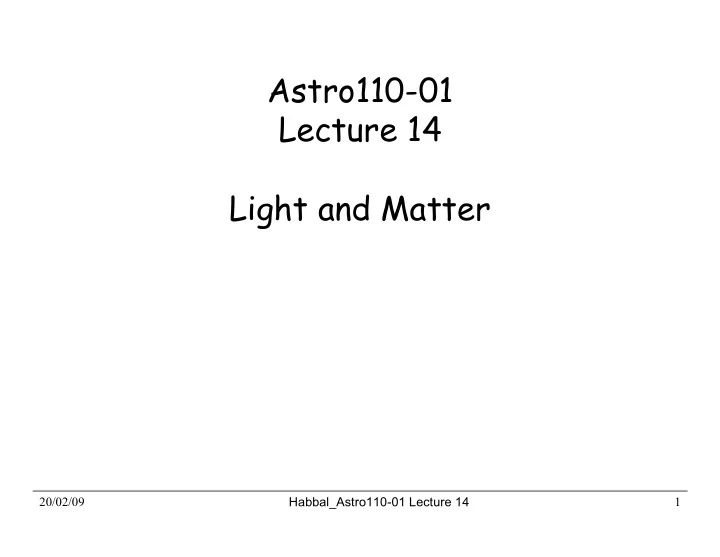

Astro110-01 Lecture 14 Light and Matter 20/02/09 Habbal_Astro110-01 Lecture 14 1
What are the building blocks of matter? Or the parts of an atom Electron cloud Nucleus Atom proton neutron mass (proton) ≅ mass (neutron) ≅ 2000 x mass(e) 20/02/09 Habbal_Astro110-01 Lecture 14 2
Atomic Terminology • Atomic Number – number of protons in nucleus • Atomic Mass Number – number of protons + neutrons 20/02/09 Habbal_Astro110-01 Lecture 14 3
Atomic Terminology (cont’d) • Isotope: – same # of protons but different # of neutrons ( 4 He, 3 He) • Molecules: - two or more atoms (H 2 O, CO 2 ) 20/02/09 Habbal_Astro110-01 Lecture 14 4
How do light and matter interact? • Emission • Absorption • Transmission: – Transparent objects transmit light. – Opaque objects block (absorb) light. • Reflection – Scattering = random reflection 20/02/09 Habbal_Astro110-01 Lecture 14 5
Reflection and Scattering Movie screen scatters light in Mirror reflects light all directions in a particular direction 20/02/09 Habbal_Astro110-01 Lecture 14 6
Interaction of Light with Matter Interaction between light and matter determines the appearance of everything around us. 20/02/09 Habbal_Astro110-01 Lecture 14 7
Probing Matter through Light: The spectrum 20/02/09 Habbal_Astro110-01 Lecture 14 8
Different ways of visualizing a spectrum 20/02/09 Habbal_Astro110-01 Lecture 14 9
Three Types of Spectra: Kirchhof’s Laws Continuous Emission Absorption 20/02/09 Habbal_Astro110-01 Lecture 14 10
Spectra of astrophysical objects are usually combinations of these three basic types Continuous Spectrum Absorption Line Spectrum Emission Line Spectrum 20/02/09 Habbal_Astro110-01 Lecture 14 11
Continuous Spectrum • The spectrum of a common (incandescent) light bulb spans all visible wavelengths, without interruption. 20/02/09 Habbal_Astro110-01 Lecture 14 12
Emission Line Spectrum • A thin or low-density cloud of gas emits light only at specific wavelengths that depend on its composition and temperature, producing a spectrum with bright emission lines. 20/02/09 Habbal_Astro110-01 Lecture 14 13
Absorption Line Spectrum • A cloud of gas between us and a light bulb can absorb light of specific wavelengths, leaving dark absorption lines in the spectrum. 20/02/09 Habbal_Astro110-01 Lecture 14 14
How does light tell us what things are made of? 20/02/09 Habbal_Astro110-01 Lecture 14 15
Recall the parts of an atom Electron cloud Nucleus Atom proton neutron 20/02/09 Habbal_Astro110-01 Lecture 14 16
Chemical Fingerprints Each type of atom has a unique spectral fingerprint 20/02/09 Habbal_Astro110-01 Lecture 14 17
Production of Emission Lines 20/02/09 Habbal_Astro110-01 Lecture 14 18
Chemical Fingerprints Energy Levels Each type of atom has a unique set of energy levels. Each transition corresponds to a unique photon energy and Energy levels of hydrogen frequency (or wavelength). E = h x f = h / λ 20/02/09 Habbal_Astro110-01 Lecture 14 19
Transitions yielding emission lines • Downward transitions produce a unique pattern of emission lines. 20/02/09 Habbal_Astro110-01 Lecture 14 20
Transitions yielding absorption lines • Because those atoms can absorb photons with those same energies, upward transitions produce a pattern of absorption lines at the same wavelengths. 20/02/09 Habbal_Astro110-01 Lecture 14 21
Production of Absorption Lines 20/02/09 Habbal_Astro110-01 Lecture 14 22
Chemical fingerprints in a spectrum indicate which kinds of atoms are present 20/02/09 Habbal_Astro110-01 Lecture 14 23
Example: the Solar Spectrum 20/02/09 Habbal_Astro110-01 Lecture 14 24
How does light tell us the temperatures of planets and stars? 20/02/09 Habbal_Astro110-01 Lecture 14 25
Thermal Radiation • Nearly all large or dense objects emit thermal radiation, including stars, planets, and you. • An object’s thermal radiation spectrum depends on only one property: its temperature. 20/02/09 Habbal_Astro110-01 Lecture 14 26
Properties of Thermal Radiation 1. Hotter objects emit more light at all frequencies per unit area. 2. Hotter objects emit photons with a higher average energy. 20/02/09 Habbal_Astro110-01 Lecture 14 27
Wien’s Law λ max = 2.9 10 6 / T (K) 20/02/09 Habbal_Astro110-01 Lecture 14 28
Recommend
More recommend